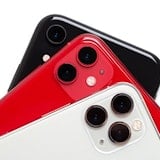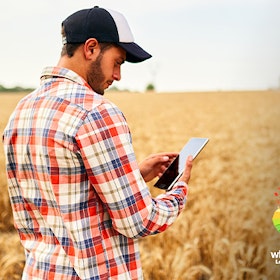 Near Field Communication, or NFC, is a relatively new piece of smartphone functionality that we’re seeing crop up in the market. In a very basic sense, NFC is essentially a secure short-range method of wireless information transferral.
Near Field Communication, or NFC, is a relatively new piece of smartphone functionality that we’re seeing crop up in the market. In a very basic sense, NFC is essentially a secure short-range method of wireless information transferral.
If all of this sounds like a new fancy kind of Blue Tooth then you’re partially correct. Blue Tooth is a fast method for wireless data transfer over small distances as well. You might even be surprised to hear that not only is Blue Tooth faster than NFC, boasting around 2.1Mbps where NFC runs at around 424Kbps, Blue Tooth also has a longer range than NFC; 10 metres compared to 20cm.
So if Blue Tooth is faster and has longer range then what’s the point of NFC? Right now there are 2 simple answers: connection time and security. NFC is also more power-efficient than Blue Tooth in most circumstances, but that isn’t a prime factor in most currently proposed uses for NFC.
If you’ve ever tried to hook two devices up over Blue Tooth then you’d know that it usually takes a few seconds to get the connection running, sometimes longer. NFC, on the other hand, takes only around a tenth of a second to connect to another device. This makes it far more ideal for quick and easy transferral of small bits and piece of information. The shorter range of NFC comes in to play here as well. Due to the devices being forced so close together and the signal not spreading out further than is needed the chances of interference are lowered dramatically.
The short signal range also significantly lowers the ability of others to gain unwanted access to your NFC transfer and use it for morally questionable purposes. It’s easy enough to be within 10 metres of someone and look inconspicuous, standing right up close to a person and jamming your phone right next to theirs while they’re performing an action is a little less subtle.
The differences between Blue Tooth and NFC aren’t important in terms of ‘which is better’, rather they help to highlight areas in which NFC is more proficient than technologies we’ve previous had widely available. It is the strengths of NFC, connection time and security, that have allowed companies such as Google and Apple to start pushing for a ‘revolution’ with any form of technology that requires a short-range, near-instantaneous transfer of digital information.
Proposed Uses for NFC
Right now there are a tonne of ideas floating around for potential NFC uses. Probably the most likely to happen early on are Security Badges, Encrypted Pass Keys to open doors, Plane or Bus Tickets, Event Tickets such as a paid pass for a concert and a smoother experience when switching between gadgets. However, probably the biggest one that already has company backing is the idea to replace credit cards with smartphones.
Phones as Digital Wallets
The idea behind the replacement of credit cards is worrying to many and exciting to others. Not having to carry around a separate card in your wallet, or potentially not needing a wallet at all, has a few foreseeable benefits. Most notably you would have cram less stuff in your pockets and thus have less items to keep track of every day. The comfort of emptier pockets is another benefit. We also like the idea of streamlining our possessions: always pulling out the same device whether it’s for socialising or making a payment just seems neater and more efficient than relying on two different items.
The way an NFC payment would currently work is by either tapping your phone against or waving your phone over a dedicated NFC payment terminal. Basically it would be like waving your credit card over a new credit card machine, except you would use your smartphone instead.
A Smoother Gadget Experience
As our world becomes more and more about gadgets it’s starting to become a hassle switching from one to another. For instance, it can be annoying if you’re reading a book or watching a movie on the bus via your phone, but when you get home you’d prefer to switch to the easier but less portable option of a tablet. Unfortunately that would mean shutting down whatever program is running on your phone, finding it on your tablet and then manually finding the spot that you were up to. It’s not exactly a life-ending situation, but it can be enough to dissuade people from continuing to enjoy their digital experience.
To battle this there are a bevy of cloud services popping up, such as Amazon’s cloud service that saves what point in a book you’re up to no matter what device you load it on.
A proposed (and already partially demonstrated) use for NFC is to ensure a similar experience when switching from a phone to a tablet, TV or computer. HP already tried this with its failed line of Palm Pre phones and its ill-fated TouchPad tablet. While the entire WebOS line of gadgets did die out, before they did HP managed to do something pretty awesome with them. The idea was that all new Palm Pre phones could transfer whatever they were doing to the TouchPad tablet by physically tapping them together. Users could look up a website, a picture, a Facebook page etc on either device and then tap them together. Doing so would instantly bring up the same content on the other device. There’s a myriad of situations in which this would be useful, such as when you look up a map on your home computer and want that same map on your phone for when you leave the house. It would be wonderfully simple to just tap your smartphone against your computer’s screen and have the map transfer instantly.
Entry Tickets
The idea of concert and plane tickets is one that has already been implemented in phones to some degree. Already with e-tickets that use barcodes it’s possible to load the ticket on a mobile device and have the screen scanned by a barcode reader. This method obviously has its drawbacks, such as digital images of barcodes are copied from one device to another easily enough. A more secure method would be an encoded file that uses wirelessly transferred data over short distances. Just activate your ‘ticket app’ or program and wave it over a detector. That’s one easy and secure method for ticketing.
Security Passes
The idea of security passes and door keys is similar to both the digital wallet and entry-ticket concepts. Already we have security devices that only require a user to wave a keycard over it in order for it to register. Why not replace the card with a phone? Once again it’s one less item to keep on you of and phones can be tracked using GPS programs or even remotely bricked if need be.
In Summary
So now you know why so many tech gurus and companies are talking about NFC as if it’s the next big thing. We don’t expect changes to happen overnight, but it’s likely that in the future you’ll be using your phone for all of these things and more.
Google Wallet is already in effect in America and a few global retail and grocery chains have already begun testing out NFC payment readers in-store. It’s nothing to be worried or intimidated about. The process is likely to be slow and as such we’ll all have plenty of time to make the adjustment. Like we said, we already do most of this stuff anyway with other items; all you’ll really be doing is using your phone for things that you already use other gadgets or cards for and there’s really not that much more to it than that.
Related Articles
Find Better Phones and Plans
Hundreds of cell phone plans unpacked. All the facts. No surprises.








































